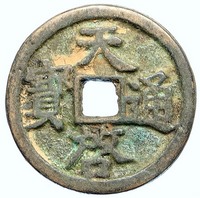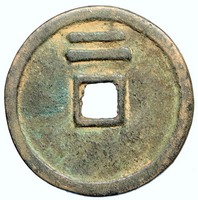China - Ming Dynasty (1368-1644 A.D.) - -Ming
Tianqi Emperor - Xi Zong (1621-27)
Bronze Tian Qi Tong Bao Cash 30mm (8.33 grams), Struck 1621-27 AD.
Reference: H# 20.181
Four Chinese characters.
Large characters.
You are bidding on the exact item pictured, provided with a Certificate of Authenticity and Lifetime Guarantee of Authenticity.
 The Tianqi Emperor (23 December 1605 – 30 September 1627), personal name Zhu Youjiao (Chinese: 朱由校; pinyin: Zhū Yóujiào), was the 16th Emperor of the Ming dynasty, reigning from 1620 to 1627. He was the eldest son of the Taichang Emperor and a elder brother of the Chongzhen Emperor, who succeeded him. "Tianqi", the era name of his reign, means "heavenly opening". The Tianqi Emperor (23 December 1605 – 30 September 1627), personal name Zhu Youjiao (Chinese: 朱由校; pinyin: Zhū Yóujiào), was the 16th Emperor of the Ming dynasty, reigning from 1620 to 1627. He was the eldest son of the Taichang Emperor and a elder brother of the Chongzhen Emperor, who succeeded him. "Tianqi", the era name of his reign, means "heavenly opening".
Zhu Youjiao became emperor at the age of 15, following the death of his father, the Taichang Emperor, who ruled less than a month. He did not pay much attention to state affairs, and was accused of failing in his filial duties to his late father by not continuing the latter's wishes. It is possible that Zhu Youjiao suffered from a learning disability or something more. He was illiterate and showed no interest in his studies. However, he was an outstanding carpenter and craftsman, often spending vast amounts of time on woodworking and instructing his servants to sell his creations undercover on the market just to see how much they were worth. Because the Tianqi Emperor was unable to read court memorials and uninterested in state affairs, the court eunuch Wei Zhongxian and the emperor's wet nurse Madam Ke seized power and controlled the Ming imperial court, with the Tianqi Emperor as merely a puppet ruler. The Tianqi Emperor apparently devoted his time to carpentry. Wei Zhongxian took advantage of the situation and began appointing the people he trusted to important positions in the imperial court. Meanwhile, Madam Ke sought to retain power by removing all other women from the emperor's harem by locking away the emperor's concubines and starving them to death. It is believed that he had two private palaces; one for his female lovers and one for his male lovers. One Confucian moralist group, the Donglin Movement, expressed distress at the conditions of the government. In response, the imperial court, under Wei Zhongxian's control, covertly ordered the execution of a number of officials associated with the Donglin Movement. Living conditions worsened during the Tianqi Emperor's reign. The Ming dynasty also faced several popular uprisings. The Tianqi Emperor died heirless on 30 September 1627 due to his only son having died in the Wanggongchang Explosion and was succeeded by his fifth and sole surviving brother, Zhu Youjian, because he had no sons to succeed him. Zhu Youjian was enthroned as the Chongzhen Emperor. As both the Tianqi Emperor's daughters died early too, it seems that there are no natural heirs from the emperor left alive. Consorts and Issue: - Empress Xiao'aizhe, of the Zhang clan (孝哀悊皇后 張氏; 1610–1644), personal name Yan (嫣)
- Zhu Ciran, Crown Prince Huaichong (懷衝皇太子 朱慈燃; 4 November 1623), first son
- Consort Hui, of the Fan clan (慧妃 范氏), later Imperial Noble Consort
- Princess Yongning (永寧公主; 1622–1624), personal name Shu'e (淑娥), first daughter
- Zhu Ciyu, Crown Prince Daohuai (悼懷皇太子 朱慈焴; 1623–1624), second son
- Consort Rong, of the Ren clan (容妃 任氏), later Imperial Noble Consort
- Zhu Cijiong, Crown Prince Xianhuai (獻懷皇太子 朱慈炅; 31 October 1625 – 30 May 1626), third son, died during the Wanggongchang Explosion
- Consort Gonghuichun, of the Duan clan (恭惠純妃 段氏; 10 May 1607 – 3 July 1629)
- Consort Cheng, of the Li clan (成妃 李氏; 1605 – 21 December 1637)
- Princess Huaining (懷寧公主; 1624), personal name Shumo (淑嫫), second daughter
- Consort Daoshunyu, of the Zhang clan (悼順裕妃 張氏; 22 August 1606 – 16 September 1623)
- Consort Liang, of the Wang clan (良妃 王氏)
- Noble Lady, of the Feng clan (貴人 馮氏)
- Noble Lady, of the Hu clan (貴人 胡氏; d. 1623)
In August and September 2009, a 42-hour television series dramatising the events during the reign of the Tianqi Emperor was shown on Chinese television – two hours per night for 21 days. It vividly showed how a hereditary monarchy can lead to the rampant abuse of power. The series ended on 17 September, just two weeks before the 60th anniversary (five 12-year cycles) of the establishment of the People's Republic of China.
The Ming dynasty was the ruling dynasty of China - then known as the Great Ming Empire - for 276 years (1368-1644) following the collapse of the Mongol-led Yuan dynasty. The Ming dynasty was the last imperial dynasty in China ruled by ethnic Han Chinese. Although the primary capital of Beijing fell in 1644 to a rebellion led by Li Zicheng (who established the Shun dynasty, soon replaced by the Manchu-led Qing dynasty), regimes loyal to the Ming throne - collectively called the Southern Ming - survived until 1683. .svg/280px-Ming_Empire_cca_1580_(en).svg.png)
Ming China around 1580 The Hongwu Emperor (ruled 1368-98) attempted to create a society of self-sufficient rural communities ordered in a rigid, immobile system that would guarantee and support a permanent class of soldiers for his dynasty: the empire's standing army exceeded one million troops and the navy's dockyards in Nanjing were the largest in the world. He also took great care breaking the power of the court eunuchs and unrelated magnates, enfeoffing his many sons throughout China and attempting to guide these princes through the Huang-Ming Zuxun, a set of published dynastic instructions. This failed spectacularly when his teenage successor, the Jianwen Emperor, attempted to curtail his uncles' power, prompting the Jingnan Campaign, an uprising that placed the Prince of Yan upon the throne as the Yongle Emperor in 1402. The Yongle Emperor established Yan as a secondary capital and renamed it Beijing, constructed the Forbidden City, and restored the Grand Canal and the primacy of the imperial examinations in official appointments. He rewarded his eunuch supporters and employed them as a counterweight against the Confucian scholar-bureaucrats. One, Zheng He, led seven enormous voyages of exploration into the Indian Ocean as far as Arabia and the eastern coasts of Africa. The rise of new emperors and new factions diminished such extravagances; the capture of the Zhengtong Emperor during the 1449 Tumu Crisis ended them completely. The imperial navy was allowed to fall into disrepair while forced labor constructed the Liaodong palisade and connected and fortified the Great Wall of China into its modern form. Wide-ranging censuses of the entire empire were conducted decennially, but the desire to avoid labor and taxes and the difficulty of storing and reviewing the enormous archives at Nanjing hampered accurate figures. Estimates for the late-Ming population vary from 160 to 200 million, but necessary revenues were squeezed out of smaller and smaller numbers of farmers as more disappeared from the official records or "donated" their lands to tax-exempt eunuchs or temples. Haijin laws intended to protect the coasts from "Japanese" pirates instead turned many into smugglers and pirates themselves. By the 16th century, however, the expansion of European trade - albeit restricted to islands near Guangzhou like Macau - spread the Columbian Exchange of crops, plants, and animals into China, introducing chili peppers to Sichuan cuisine and highly productive corn and potatoes, which diminished famines and spurred population growth. The growth of Portuguese, Spanish, and Dutch trade created new demand for Chinese products and produced a massive influx of Japanese and American silver. This abundance of specie remonetized the Ming economy, whose paper money had suffered repeated hyperinflation and was no longer trusted. While traditional Confucians opposed such a prominent role for commerce and the newly rich it created, the heterodoxy introduced by Wang Yangming permitted a more accommodating attitude. Zhang Juzheng's initially successful reforms proved devastating when a slowdown in agriculture produced by the Little Ice Age joined changes in Japanese and Spanish policy that quickly cut off the supply of silver now necessary for farmers to be able to pay their taxes. Combined with crop failure, floods, and epidemic, the dynasty collapsed before the rebel leader Li Zicheng, who was defeated by the Manchu-led Eight Banner armies who founded the Qing dynasty.
|


 The Tianqi Emperor (23 December 1605 – 30 September 1627), personal name Zhu Youjiao (Chinese: 朱由校; pinyin: Zhū Yóujiào), was the 16th Emperor of the Ming dynasty, reigning from 1620 to 1627. He was the eldest son of the Taichang Emperor and a elder brother of the Chongzhen Emperor, who succeeded him. "Tianqi", the era name of his reign, means "heavenly opening".
The Tianqi Emperor (23 December 1605 – 30 September 1627), personal name Zhu Youjiao (Chinese: 朱由校; pinyin: Zhū Yóujiào), was the 16th Emperor of the Ming dynasty, reigning from 1620 to 1627. He was the eldest son of the Taichang Emperor and a elder brother of the Chongzhen Emperor, who succeeded him. "Tianqi", the era name of his reign, means "heavenly opening". .svg/280px-Ming_Empire_cca_1580_(en).svg.png)

